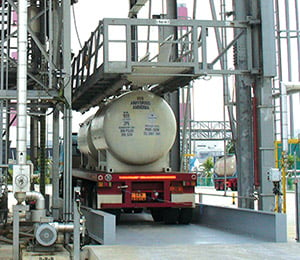It happens all the time. You’ve probably heard plenty of the stories. In fact, it’s a well-known fact in the truck loading industry: How well a driver spots a truck is more important than any other safety solution that follows.
Despite this truth being well known, proper truck spotting is also one of the hardest practices to instill into your drivers and operators. But, in order for your facility to be considered MSHA or OSHA compliant, your drivers must demonstrate correct truck spotting practices.
Here are 4.5 steps to making sure your team’s truck spotting practices are meeting OSHA compliance and preventing fatal falls.
Step #1: Take Any Immediate Required Action:
If you’ve just experienced an OSHA citation or actual incident at your facility, your first step is to correct any immediate problem areas in your truck spotting practice. Before you’re able to fix long-term issues, you must address the crisis at hand. One good place to begin is with the OSHA compliance assistance quick start program.
Step #2: Forecast Future Fall Prevention Needs
Once you’ve solved your immediate problems, it’s time to forecast your future needs so truck spotting continues smoothly in the future. Many loading spots have evolved over time as various truck shapes and sizes demand new practices and processes. It’s usually these small changes over time that produce unsafe truck spotting since small alterations are difficult to detect.
You should also investigate old loading locations that may have been retrofitted with a cheaper, shortcut solution. In reality, cheaper substitutes to safety equipment are rarely cheaper in the long run since they’re more likely to cause accidents or expensive lawsuits in the future.
Step #3: Take Related Risks Into Consideration
When considering a piece of fall prevention equipment, conduct a thorough risk analysis of the truck loading or unloading process. Before you decide on a particular piece of equipment, confirm that it doesn’t present new risks to your operator in the process of preventing falls.
For example, working with a heavier-than-air chemical like chlorine can create gaseous clouds that are fatal to your operators. In this case, you don’t want to use a tie-off safety solution since operators wouldn’t be able to safely and quickly get away from the chemical clouds.
Step #4: Adapt To Vehicle And Access Types
When your loading process or safety equipment is designed around one product or truck type, truck spotting becomes fairly routine. But once your loading facility must deal with different truck shapes, sizes and loading processes, you need truck spotting practices that adapt to changing demands.
their hatches are more difficult to access. And finally, new chemical “bladder” trucks are often loaded from the back but require more attention to the possibility of environmental hazards and spills.
Step #4.5: Strive For Safety, Not Just Compliance
When it comes to proper truck spotting, you need to strive for more than just being OSHA compliant. Not only are OSHA requirements often less stringent than internal corporate standards, but perfect compliance is never equal to perfect safety.
Far too many facility managers and safety captains rush to install a workplace safety solution without taking the time to consider all the related risks and possibilities. The failure to strive for safety instead of mere compliance often gives these leaders the illusion of safety – without the reality of a safer workplace.
Just because a safety issue isn’t pressing at your truck loading or unloading facility doesn’t mean you shouldn’t be improving the process, and truck spotting is no exception. Use these 4.5 steps to teach your drivers a more thorough truck spotting process so everyone goes home safe at the end of the shift.
Have your employees been overlooking the critical safety practice of truck spotting? Click below to download a tip sheet from Carbis Solutions and discover how to harness this human element for safer truck loading and unloading.





